Does Your Dog Need A Ramp?
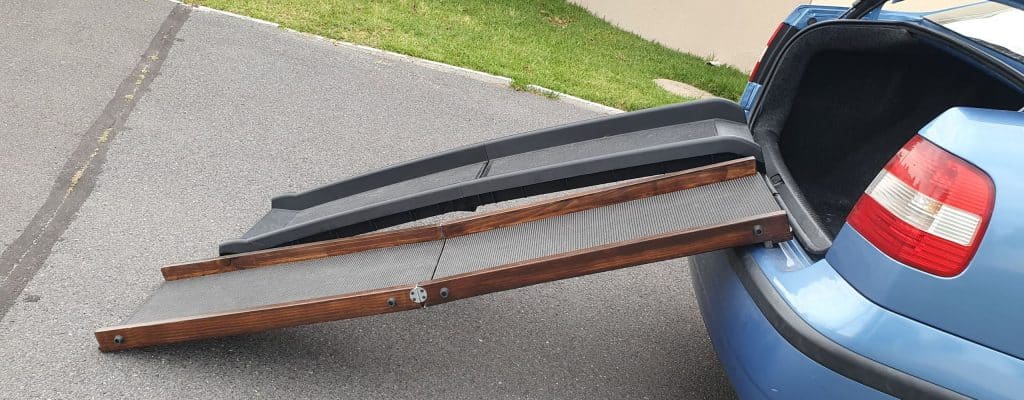
The Surprising Truth About Dog Ramps
As dog parents, we’re always looking for ways to keep our furry kids safe, healthy, and comfortable. When searching for the best dog ramps South Africa has to offer, you might think of a dog ramp as something that helps your dog get up onto the couch or into the car, but here’s the truth: ramps are even more important for protecting your dog from the impact of jumping down. Every time your dog jumps down from a height, they’re exposed to concussive forces that can jar their joints and cause long-term damage. This isn’t just something to think about as they get older—using a ramp from a young age can prevent pain and injuries later in life. Puppies may seem to take everything in their stride, but those repeated impacts compound as they age. I’ve seen it firsthand with my dog, Emmy – using a ramp is more than just providing a helpful tool—it’s an act of love that protects your dog’s well-being every day.
Table of Contents
The journey to building the perfect dog car ramp
In December 2017, my baby girl, Emmy, ruptured her Cranial Cruciate Ligament (CCL), and everything changed. Before that, both Emmy and Oscar jumped in and out of the car with ease, and I hadn’t even thought about needing a ramp. But, after speaking with Emmy’s surgeon and learning how common injuries like CCL tears, IVDD, and joint issues are in dogs, I realized I needed a long-term solution. At 20kgs, picking Emmy up every time she needed to get in or out of the car wasn’t practical—and she wasn’t fond of being lifted anyway. That’s when I started researching ramps.
A friend loaned me a plastic ramp to try out, but their dogs never used it because they were fearful of it. After trying it with Emmy, I quickly realized it wasn’t the right option. It didn’t have enough grip, and although I wouldn’t call it flimsy, it certainly didn’t feel solid or stable enough for Emmy’s needs. That’s when I decided to take matters into my own hands.
The first ramp was built from wood and leftover carpeting, and while it worked well, it was heavy, and the carpet became unhygienic after muddy walks. So, I got to work on version 2.0. This time, I slimmed down the sides, reinforced the folding joints with metal to improve strength and stability, and replaced the carpet with rubber for better grip and hygiene. Emmy loved it—and so did I.

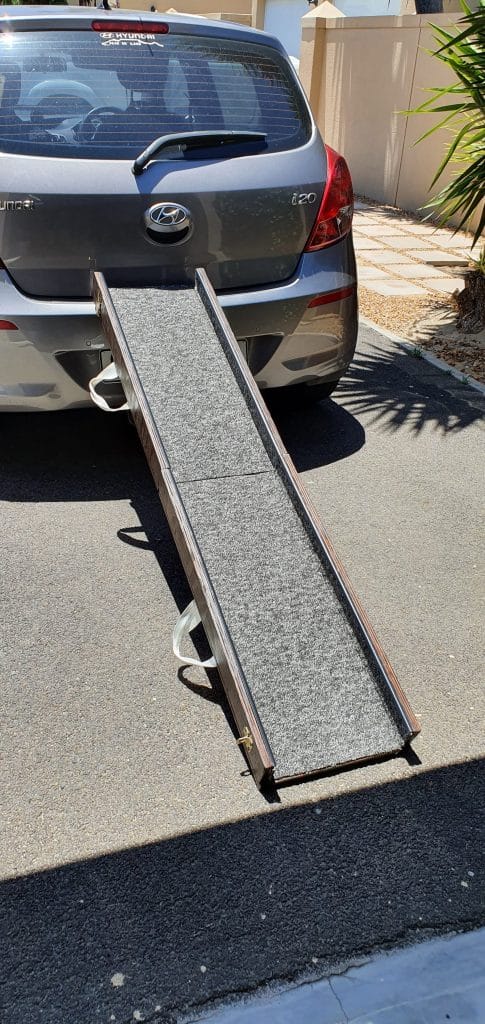
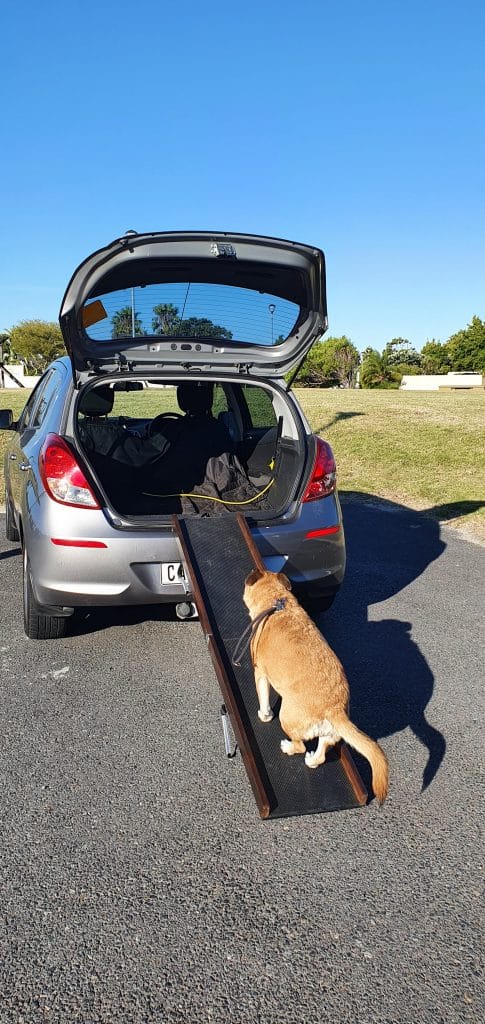
As Emmy began using her ramp regularly, something amazing happened—it started getting noticed. Her vet physios and vets saw how well it worked for her, and they began asking if I would be open to making more ramps for other dogs in need. I jumped at the chance to help others avoid the pain of watching their dogs suffer from preventable injuries, something I wish I had known about earlier.
Since then, I’ve been proud to help many dog parents protect their dogs, especially larger breeds that are harder to lift in and out of the car. Little dogs are easy to pick up, but bigger dogs need something strong, reliable, and safe. That’s why the focus has always been on ensuring the handcrafted car ramps are as sturdy as possible. In fact, I’ve now had custom hinges manufactured to add even more strength to my already solid designs…lets welcome Version 3.0.
A longer ramp was developed specifically for SUVs and taller cars, focusing not just on height but on ensuring a safe incline. A good ramp should have an incline between 18 to 25 degrees to minimize stress on your dog’s joints. The gentler the slope, the safer it is for your dog to move up and down without causing undue pressure on their joints.
Creating Strong and Reliable Couch and Bed Dog Ramps in South Africa
After Emmy’s CCL surgery, it wasn’t just the car that posed a challenge for her—it was also getting up and down from the couch. Like many larger breeds, Emmy loved her couch cuddle time, and I wanted to ensure she could enjoy it without the strain of jumping. Having seen how well the rubber grip worked on her car ramp, I knew I needed to use it for indoor ramps too. The rubber not only gave Emmy the traction she needed but was also incredibly hygienic—it’s easy to clean and doesn’t harbour dust mites, unlike fabric or carpeting.
When I looked at local ramp options, I found that most were designed for small dogs, with a weight capacity of only 25kgs. I quickly realized there was a gap in the market for parents of larger breed dogs who needed a strong, reliable ramp for their pets to join them on the couch or bed.
That’s when I set out to design a strong, durable couch ramp that could handle bigger dogs with ease. The first versions I made had wooden, hand-cut adjustment tracks for height adjustment, which worked well. But as I continued to refine the design, I wanted to ensure complete peace of mind when it came to supporting larger breeds. So, I upgraded the adjustment tracks to steel, making the ramps even stronger and more reliable.
When it came to bed ramps, I added a special feature: removable rails that can be placed on either side of the ramp, depending on your room’s layout. Both the couch and bed ramps are adjustable to various heights and can fold down to fit under most beds or into a cupboard, offering convenience without compromising on strength or safety. With the same rubber grip that Emmy was already comfortable with, these ramps provide the security and hygiene needed for larger dogs, ensuring they can enjoy their cuddle time without the risk of injury from jumping.
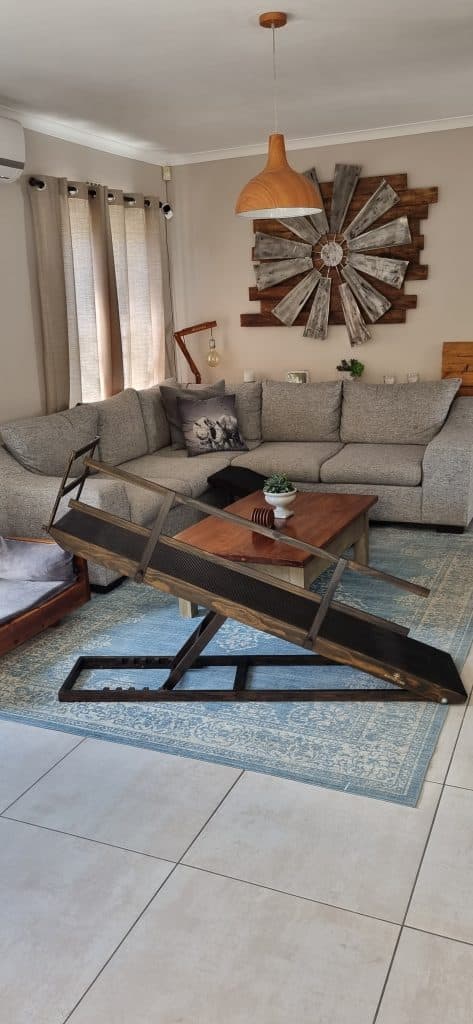
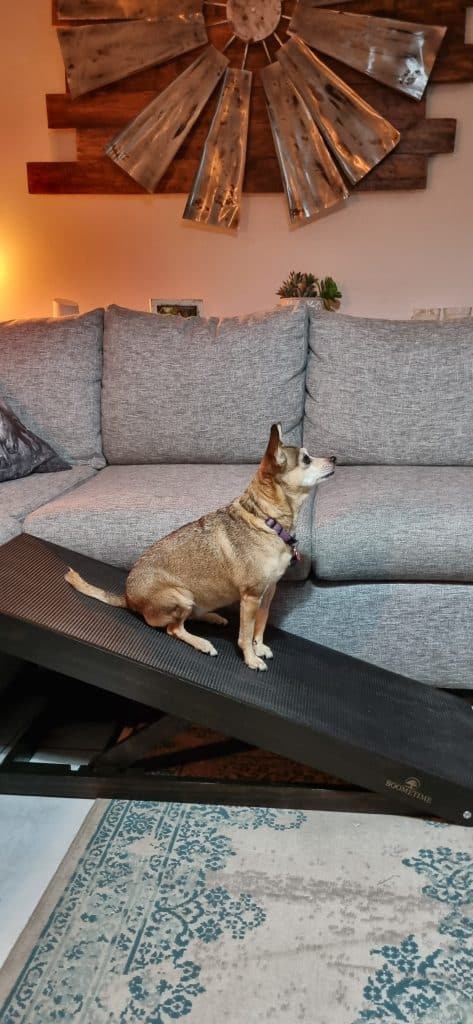
“Dog Mom is definitely my first call when it comes to recommendations for my clients. As a veterinary physiotherapist, I often deal with patients who range from mild to severe physical compromise, and no matter the degree, we always recommend reducing the stress of jumping on and off high surfaces. Sandra’s attention to detail and understanding of the value of a strong and low-gradient ramp make her ramps superior in the market.”
Kirsten Straszacker
Veterinary Physiotherapist and Owner of Startline Veterinary Physiotherapy
Why Every Dog Parent in South Africa Should Consider a Dog Ramp
Ramps aren’t just for senior dogs or those recovering from injuries—they’re an essential tool for all dogs, no matter their age or size. We often don’t think about it when our furry kids are young and spry, but the truth is, even puppies face the impact of jumping down from cars, beds, or couches. It may seem like they take it in stride, but over time, those jumps can take a toll on their joints. The concussive forces that occur when dogs land after a jump put pressure on their legs, hips, and spine, and it all adds up as they age.
Using a ramp from an early age is one of the simplest ways to protect your dog’s long-term health. Whether it’s a bed, couch, or car ramp, you’re giving them the gift of safety and comfort. Ramps help prevent common issues like torn ligaments, arthritis, or worse, serious conditions like CCL tears and IVDD. By reducing the strain on their joints, you’re helping your dog avoid unnecessary pain in the future. Think of it as a proactive way to protect their body and keep them mobile for years to come.
For larger dogs especially, a ramp is a game-changer. Picking up a big dog isn’t always easy—or even possible—and ramps provide a safe and sturdy alternative. That’s why I’ve designed my ramps to be as strong as possible, using custom hinges and durable materials, ensuring that no matter your dog’s size, they’re fully supported with every step. And when it comes to everyday use, having a ramp that’s stable and easy to grip makes all the difference for your dog’s confidence and comfort.
How to Choose the Right Ramp for Your Dog in South Africa
Choosing the right ramp for your furry kid is about more than just finding something that fits your space—it’s about making sure the ramp is suited to your dog’s specific needs, keeping them safe and comfortable.
1. Consider Your Dog’s Size and Weight
The size of your dog is one of the most important factors when selecting a ramp. Larger dogs need a ramp that’s strong and durable enough to support their weight without flexing or wobbling. That’s why my lovingly handcrafted ramps are designed with custom hinges and reinforced materials, so even the biggest dogs can move safely and confidently. For smaller dogs, a more lightweight ramp can work just as well, but it’s still essential that it’s stable and easy to grip to avoid slipping.
“As a dog trainer, behaviourist, and owner of a doggy daycare/kennel, I frequently recommend Dog Mom car and couch ramps to my clients with elderly dogs, both big and small. Especially to clients with large and giant breed puppies to avoid any injury to their developing joints and bones. These ramps are so wonderfully crafted with both function and elegance in mind. Sandra’s passion for dogs and their well-being is very evident, especially her attention to detail. Her client service goes above and beyond as well!”
Kerry McDonald
Owner of Pet-i-Ket Daycare, Training & Kennels
2. Think About Where You’ll Use It
Where your dog needs the ramp will determine the ideal length and incline. If it’s for getting into the car, a longer ramp with a gentle incline is key—especially for taller vehicles like SUVs (the incline needs to be 18 to 25 degrees to prevent strain on your dog’s joints.) For indoor use, like getting onto the couch or bed, I’ve carefully designed my ramps at just the right length to give the ideal incline for most setups. After several design iterations, I’ve had custom metal adjustment rails made to replace the wooden ones, ensuring even greater strength and safety for your dog. Whether it’s a car, couch, or bed ramp, you can be sure they’re built for smooth, secure movement.
3. Look for Stability, Grip, and Style
Stability and grip are crucial, especially for dogs who might be hesitant to use a ramp. Dog Mom ramps are built with sturdy materials to ensure they stay in place, no matter where you set them up. Plus, I’ve used high-quality rubber traction on the surface to give your dog confidence with every step. And because these ramps may become part of your everyday furniture, I’ve taken extra care in their design—no exposed screws, and meticulous attention to detail to ensure they look good in your home. The dark wood stain finish beautifully complements the black rubber surface, but I can also offer customised colours to match your home’s style.
4. Ease of Use
A ramp should make life easier for both you and your dog. That’s why the ramps fold easily and are built to be lightweight enough to move around as needed. Whether you’re traveling or just need to store it away, the foldable design ensures it’s easy to use and convenient to pack up. No hassle—just a practical solution that keeps your dog safe and your routine simple.
Conclusion: Finding the Perfect Dog Ramps in South Africa for Your Dog
Choosing the right ramp isn’t just about convenience—it’s an investment in your dog’s long-term health and mobility. My ramps are lovingly handcrafted with attention to detail, not mass-manufactured, ensuring that each one is built to last, offering strength, safety, and style.
Whether your furry kid is recovering from an injury, dealing with joint pain, or simply needs help with everyday mobility, these ramps provide the support they need while adding an aesthetic touch to your home. By choosing a handcrafted Dog Mom ramp, you’re protecting your dog’s joints and well-being for years to come.
Looking for more specific details? Explore the individual ramps I’ve created to suit all your dog’s needs:
Car Ramps: Perfect for helping your dog get in and out of normal-sized vehicles with ease, designed to provide a safe incline while supporting large dogs.
SUV Ramps: Built specifically for taller vehicles like SUVs, these ramps offer a longer design with a gentler incline to ensure safe access, especially for large dogs.
Bed Ramps: Designed to help your dog safely get onto higher surfaces, featuring a removable railing for extra protection and guidance, preventing them from jumping off halfway.
Couch Ramps: Compact and sturdy, providing a stylish solution for everyday use around the house.
FAQs: Dog Ramps
1. What’s the ideal incline for a dog ramp?
The ideal incline for a dog ramp is between 18-25 degrees, depending on your dog’s size and health. A gentler incline (18-20 degrees) is best for older dogs or those with joint issues, while a steeper incline (closer to 25 degrees) is generally suitable for healthy dogs. For larger vehicles like SUVs, a longer ramp with a gentle slope is necessary to reduce strain on your dog’s joints.
2. How do I train my dog to use a ramp?
Training your dog to use a ramp requires patience and positive reinforcement. Start by laying the ramp flat on the ground and use treats or toys to guide your dog across it. Gradually increase the incline as they grow more comfortable. The non-slip rubber surface on my ramps helps dogs feel secure and builds their confidence in using the ramp.
➡️ For more details, you can check out my dedicated post on Training Your Dog to Use a Ramp.
3. Are ramps only for older dogs?
No, ramps can benefit dogs of all ages. While older dogs with joint issues may need them more urgently, using a ramp from an early age helps prevent long-term joint damage caused by repetitive jumping. Larger dogs, in particular, can face more stress on their joints when jumping, so starting them with a ramp early can improve their long-term mobility.
4. What sets Dog Mom ramps apart from other Dog Ramps in South Africa?
Dog Mom ramps are lovingly handcrafted and designed to support larger dogs that need extra strength and stability. Unlike many imported plastic or aluminum ramps that can be expensive due to shipping costs and often lack sufficient traction, my ramps are locally handmade, competitively priced, and feature high-quality rubber for superior grip. This ensures both affordability and safety, giving dog parents peace of mind without the high costs typically associated with stronger or longer ramps.
5. Are Dog Ramps better than Dog Steps?
There’s no one-size-fits-all answer—what works best depends on your dog’s needs! Some dogs navigate steps easily, while others (especially seniors, pups with joint issues, or those with mobility concerns) may find a ramp much gentler on their bodies. Ramps provide a gradual incline, reducing strain on joints, whereas steps can be more compact and take up less space. If you’re unsure which is the right choice for your furry kid, check out this detailed comparison here: Dog Ramps vs. Dog Steps
“As a Veterinary Rehabilitation Practitioner, I highly recommend these ramps for any pet with orthopedic or spinal issues. I personally purchased an adjustable bed ramp from Sandra, and it has been a game-changer for my dogs. The ramp’s correct angle reduces concussive forces on joints, especially during downward movement, preventing accidents and minimizing strain. The durable design, combined with excellent traction from the rubber surface, ensures my dogs can move up and down safely without slipping.”
Lorren Barham
Owner of Pet Wellness Worx:
Final Thoughts
As someone who’s been through the ups and downs of caring for a dog with joint issues, I understand how overwhelming it can be to navigate all the products and advice out there. That’s why I created these ramps—not just as a solution for Emmy, but as a way to help other dog parents who want to give their furry kids the best care possible. Whether your dog is young, old, big, or small, my ramps are designed with love, care, and attention to detail.
If you’re unsure which ramp might be best for your dog, or if you have any questions about helping your dog transition to using a ramp, please feel free to reach out. I’m always here to offer advice and guide you through the process.
Together, we can make sure our dogs enjoy the comfort and safety they deserve.


